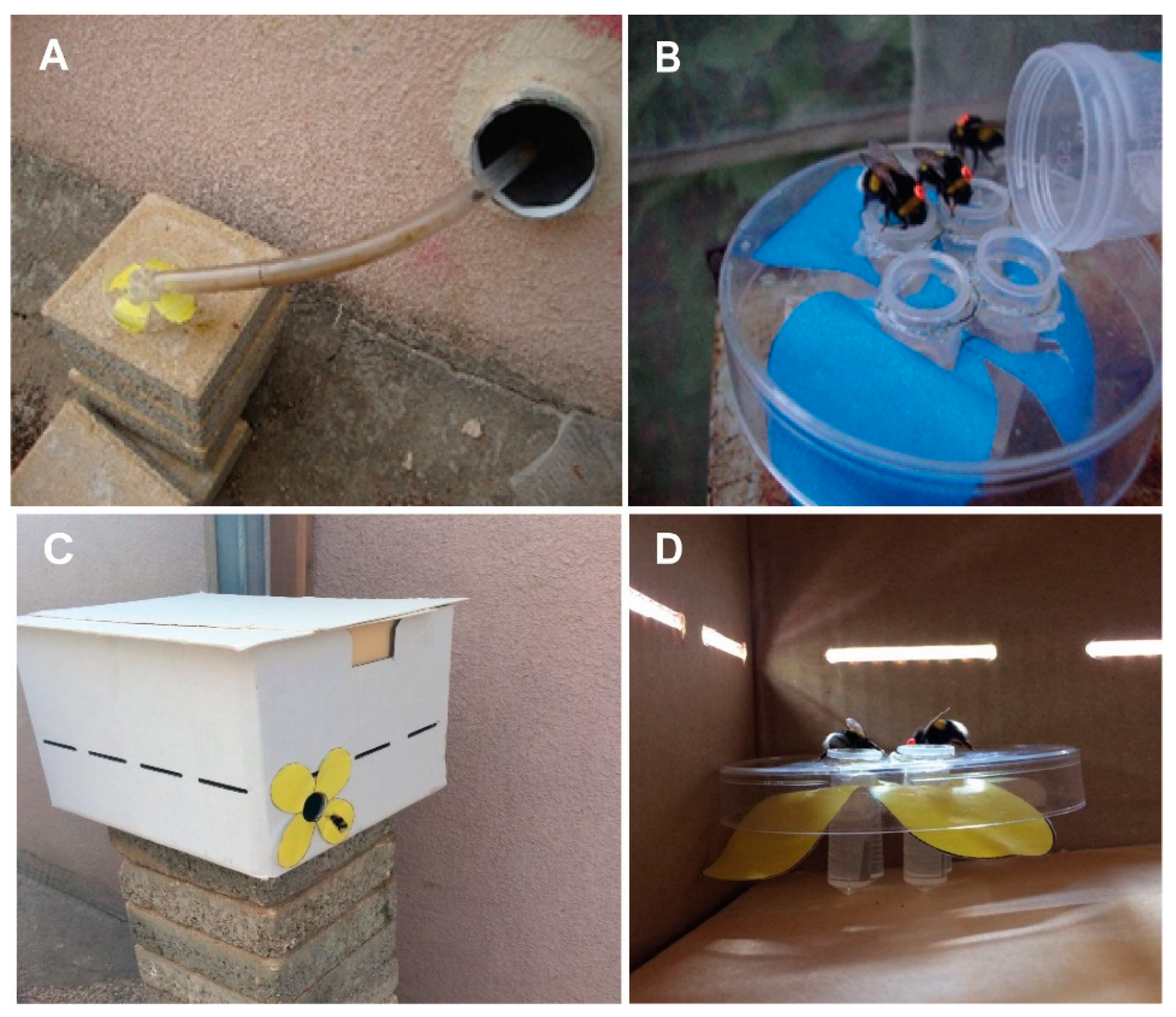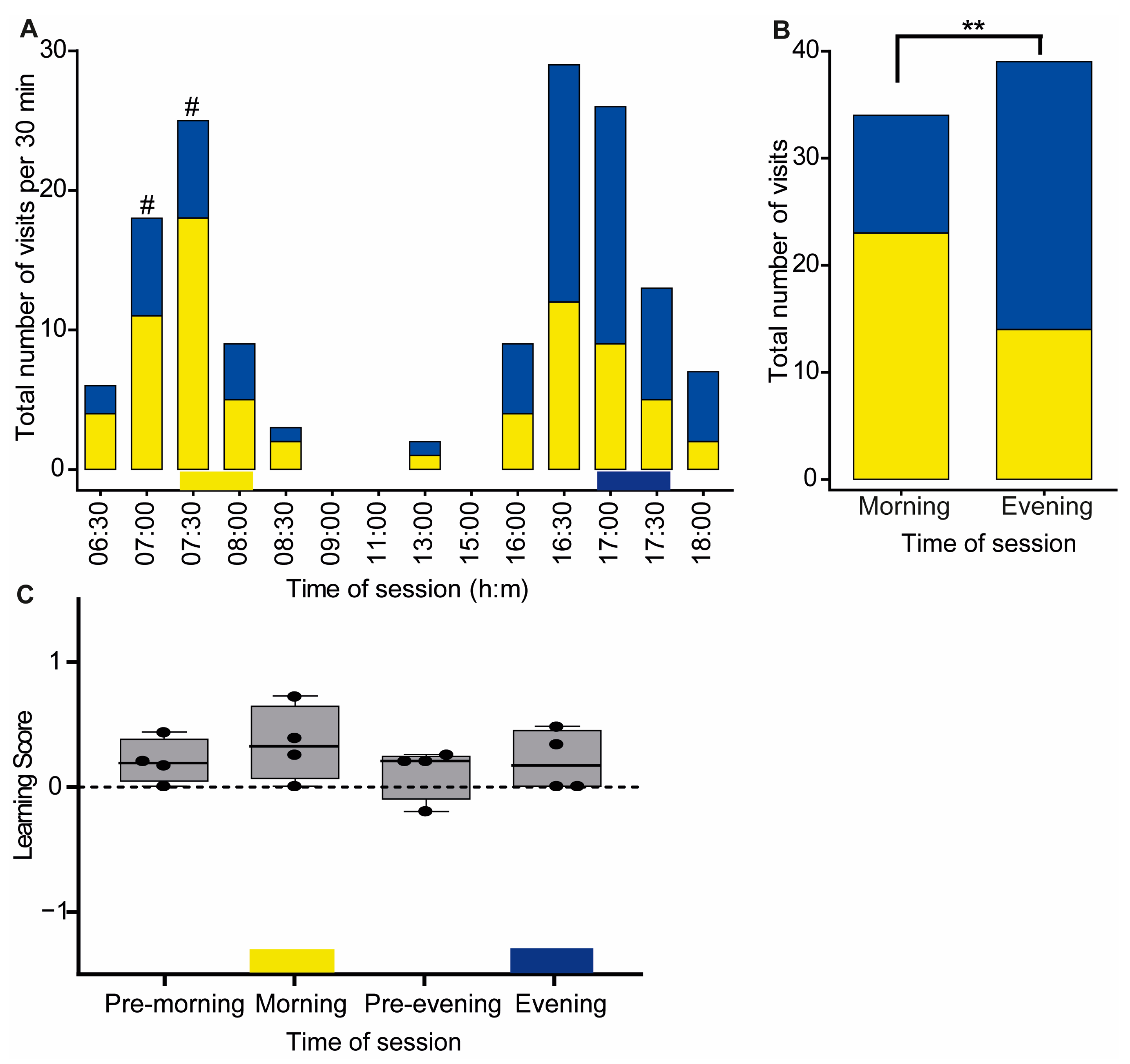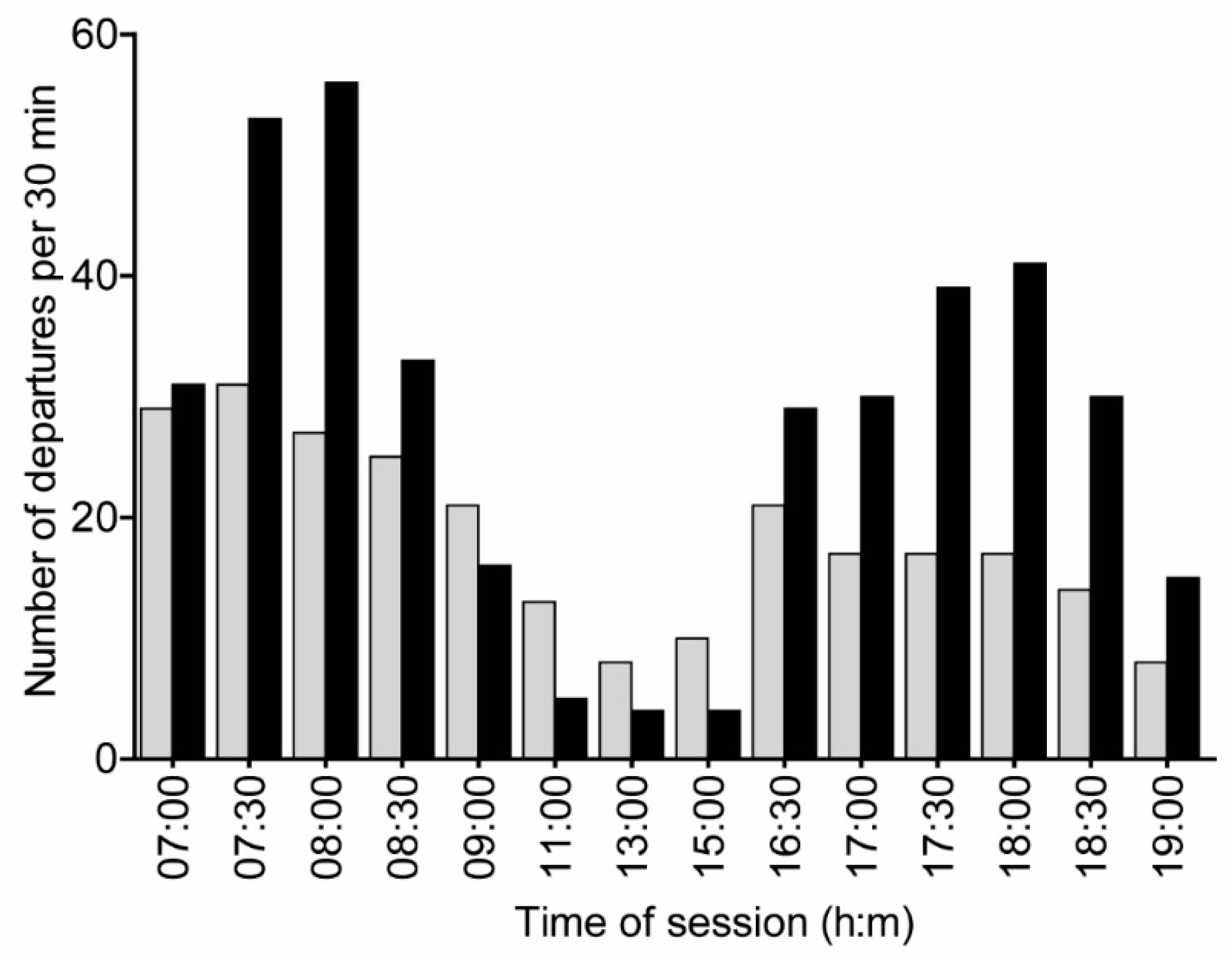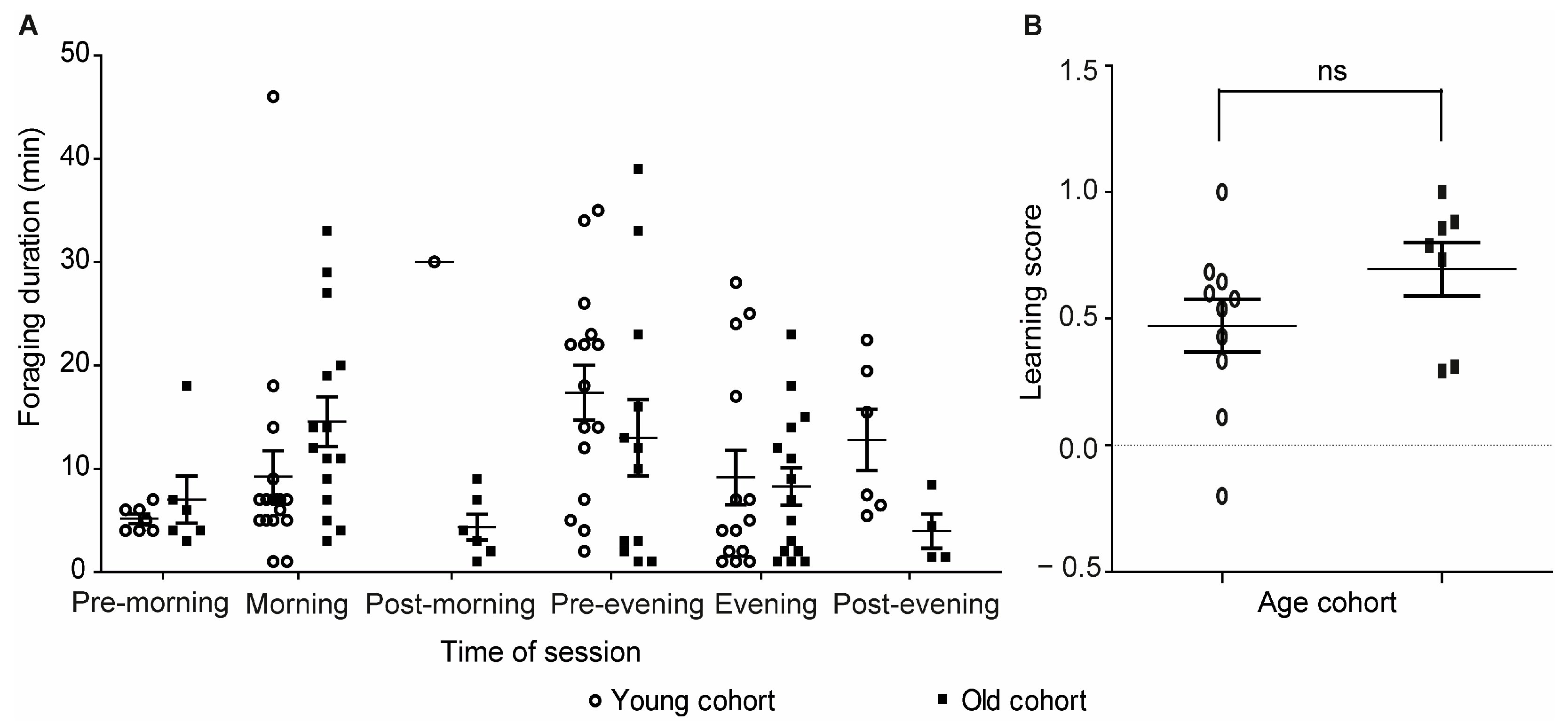Bumble Bees (Bombus terrestris) Use Time-Memory to Associate Reward with Color and Time of Day
Abstract
Simple Summary
Abstract
1. Introduction
2. Materials and Methods
2.1. Bees
2.2. Time Training
2.3. Statistical Analysis
3. Results
3.1. Experiment 1
3.2. Experiment 2
4. Discussion
Supplementary Materials
Author Contributions
Funding
Data Availability Statement
Acknowledgments
Conflicts of Interest
References
- Benirschke, K. Chronobiology: Biological timekeeping. J. Hered. 2004, 95, 91–92. [Google Scholar] [CrossRef]
- Helm, B.; Visser, M.E.; Schwartz, W.; Kronfeld-Schor, N.; Gerkema, M.; Piersma, T.; Bloch, G. Two sides of a coin: Ecological and chronobiological perspectives of timing in the wild. Philos. Trans. R. Soc. B Biol. Sci. 2017, 372, 20160246. [Google Scholar] [CrossRef]
- Sharma, V.K. Adaptive significance of circadian clocks. Chronobiol. Int. 2003, 20, 901–919. [Google Scholar] [CrossRef] [PubMed]
- Yerushalmi, S.; Green, R.M. Evidence for the adaptive significance of circadian rhythms. Ecol. Lett. 2009, 12, 970–981. [Google Scholar] [CrossRef] [PubMed]
- Allada, R.; Chung, B.Y. Circadian organization of behavior and physiology in Drosophila. Annu. Rev. Physiol. 2010, 72, 605–624. [Google Scholar] [CrossRef] [PubMed]
- Dubowy, C.; Sehgal, A. Circadian rhythms and sleep in Drosophila melanogaster. Genetics 2017, 205, 1373–1397. [Google Scholar] [CrossRef]
- Manjunatha, T.; Dass, H.; Sharma, S.K. Egg-laying rhythm in Drosophila melanogaster. J. Genet. 2008, 87, 495–504. [Google Scholar]
- Saunders, D.S.; Steel, C.G.H.; Vafopoulou, X.; Lewis, R.D. Insect Clocks; Elsevier: Amsterdam, The Netherlands, 2002; pp. 449–472. [Google Scholar] [CrossRef]
- Tataroglu, O.; Emery, P. Studying circadian rhythms in Drosophila melanogaster. Methods 2014, 68, 140–150. [Google Scholar] [CrossRef]
- Bloch, G. Plasticity in the circadian clock and the temporal organization of insect societies. In Organization of Insect Societies; Harvard University Press: Cambridge, MA, USA, 2009; pp. 402–432. [Google Scholar] [CrossRef]
- Moore, D. Mini-Review Honey bee circadian clocks: Behavioral control from individual workers to whole-colony rhythms. J. Insect Physiol. 2001, 47, 843–857. [Google Scholar] [CrossRef]
- Shpigler, H.Y.; Yaniv, A.; Gernat, T.; Robinson, G.E.; Bloch, G. The influences of illumination regime on egg-laying rhythms of honey bee queens. J. Biol. Rhythm. 2022, 37, 609–619. [Google Scholar] [CrossRef]
- Beekman, M.; Ratnieks, F.L.W. Long-range foraging by the honey-bee, Apis mellifera L. Funct. Ecol. 2000, 14, 490–496. [Google Scholar] [CrossRef]
- Von Frisch, K. The Dance Language and Orientation of Bees; Harvard University Press: Cambridge, MA, USA, 1967. [Google Scholar] [CrossRef]
- Biebach, H.; Gordijn, M.; Krebst, J.R. Time-and-place learning by Garden Warblers, Sylvia borin. Anim. Behav. 1989, 37, 353–360. [Google Scholar] [CrossRef]
- Chouhan, N.S.; Wolf, R.; Helfrich-Förster, C.; Heisenberg, M. Flies remember the time of day. Curr. Biol. 2015, 25, 1619–1624. [Google Scholar] [CrossRef] [PubMed]
- Harrison, J.M.; Breed, M.D. Temporal learning in the giant tropical ant, Paraponera clavata. Physiol. Entomol. 1987, 12, 317–320. [Google Scholar] [CrossRef]
- Reebs, S.G. Time-place learning in Golden Shiners (Pisces: Cyprinidae). Behav. Process. 1996, 36, 253–262. [Google Scholar] [CrossRef]
- Van der Zee, E.A.; Havekes, R.; Barf, R.P.; Hut, R.A.; Nijholt, I.M.; Jacobs, E.H.; Gerkema, M.P. Circadian time-place learning in mice depends on Cry genes. Curr. Biol. 2008, 18, 844–848. [Google Scholar] [CrossRef]
- Beling, I. Uber Das Zeitgedachtnis Der Bienen. J. Comp. Physiol. 1929, 9, 259–338. [Google Scholar]
- Wahl, O. Beitrag zur frage der biologischen bedeutung des Zeitgedächtnisses der bienen. Z. Vgl. Physiol. 1932, 18, 709–717. [Google Scholar] [CrossRef]
- Woodard, S.H.; Lozier, J.D.; Goulson, D.; Williams, P.H.; Strange, J.P.; Jha, S. Molecular tools and bumble bees: Revealing hidden details of ecology and evolution in a model system. Mol. Ecol. 2015, 24, 2916–2936. [Google Scholar] [CrossRef]
- Cueva Del Castillo, R.; Sanabria-Urb An, S.; Serrano-Meneses, M.A.; Serrano-Meneses, A. Trade-offs in the evolution of bumblebee colony and body size: A comparative analysis. Ecol. Evol. 2015, 5, 3914–3926. [Google Scholar] [CrossRef]
- Walther-Hellwig, K.; Frankl, R. Foraging habitats and foraging distances of bumblebees, Bombus spp. (Hym., Apidae), in an agricultural landscape. J. Appl. Entomol. 2000, 124, 299–306. [Google Scholar] [CrossRef]
- Wolf, S.; Moritz, R.F.A. Foraging distance in Bombus terrestris L. (Hymenoptera: Apidae). Apidologie 2008, 39, 419–427. [Google Scholar] [CrossRef]
- Dornhaus, A.; Chittka, L. Information flow and regulation of foraging activity in bumble bees (Bombus spp.). Apidologie 2004, 35, 183–192. [Google Scholar] [CrossRef]
- Dornhaus, A.; Chittka, L. Bumble bees (Bombus terrestris) store both food and information in honeypots. Behav. Ecol. 2005, 16, 661–666. [Google Scholar] [CrossRef][Green Version]
- Renner, M.A.; Nieh, J.C. Bumble bee olfactory information flow and contact-based foraging activation. Insectes Sociaux 2008, 55, 417–424. [Google Scholar] [CrossRef]
- Pearce, R.F.; Giuggioli, L.; Rands, S.A. Bumblebees can discriminate between scent-marks deposited by conspecifics. Sci. Rep. 2017, 7, 43872. [Google Scholar] [CrossRef]
- Saleh, N.; Scott, A.G.; Bryning, G.P.; Chittka, L. Distinguishing signals and cues: Bumblebees use general footprints to generate adaptive behaviour at flowers and nest. Arthropod-Plant Interact. 2007, 1, 119–127. [Google Scholar] [CrossRef]
- Schmitt, U. Hydrocarbons in tarsal glands of Bombus terrestris. Experientia 1990, 46, 1080–1082. [Google Scholar]
- Sunrise and Sunset Times in Jerusalem. Available online: https://www.timeanddate.com/sun/israel/jerusalem?month=9&year=2020&as_qdr=y15 (accessed on 2 August 2022).
- Weather in Jerusalem. 2020. Available online: https://www.timeanddate.com/weather/israel/jerusalem/historic?month=9&year=2020 (accessed on 3 August 2022).
- Sunrise and Sunset Times in Jerusalem. Available online: https://www.timeanddate.com/sun/israel/jerusalem?month=7&year=2021 (accessed on 1 December 2022).
- Weather in Jerusalem. 2021. Available online: https://www.timeanddate.com/weather/israel/jerusalem/historic?month=7&year=2021 (accessed on 1 December 2022).
- Yerushalmi, S.; Bodenhaimer, S.; Bloch, G. Developmentally determined attenuation in circadian rhythms links chronobiology to social organization in bees. J. Exp. Biol. 2006, 209, 1044–1051. [Google Scholar] [CrossRef] [PubMed]
- Barr, D.J.; Levy, R.; Scheepers, C.; Tily, H.J. Random effects structure for confirmatory hypothesis testing: Keep it maximal. J. Mem. Lang. 2013, 68, 255–278. [Google Scholar] [CrossRef]
- Bates, D.; Mächler, M.; Bolker, B.M.; Walker, S.C. Fitting linear mixed-effects models using Lme4. J. Stat. Softw. 2015, 67, 48. [Google Scholar] [CrossRef]
- Lehmann, M.; Gustav, D.; Galizia, C.G. The early bee catches the flower—Circadian rhythmicity influences learning performance in honey bees, Apis mellifera. Behav. Ecol. Sociobiol. 2011, 65, 205–215. [Google Scholar] [CrossRef] [PubMed]
- Moore, D.; Siegfried, D.; Wilson, R.; Rankin, M.A. The influence of time of day on the foraging behavior of the honeybee, Apis mellifera. J. Biol. Rhythm. 1989, 4, 305–325. [Google Scholar]
- Moore, D.; Rankin, M.A. Diurnal changes in the accuracy of the honey bee foraging rhythm. Biol. Bull. 1983, 164, 471–482. [Google Scholar] [CrossRef]
- Collett, T.S.; de Ibarra, N.H.; Riabinina, O.; Philippides, A. Coordinating compass-based and nest-based flight directions during bumblebee learning and return flights. J. Exp. Biol. 2013, 216 Pt 6, 1105–1113. [Google Scholar] [CrossRef]
- Menzel, R. Serial position learning in honeybees. PLoS ONE 2009, 4, e4694. [Google Scholar]
- Moore, D.; Doherty, P. Acquisition of a time-memory in forager honey bees. J. Comp. Physiol. A 2009, 195, 741–751. [Google Scholar] [CrossRef]
- Wagner, A.E.; Van Nest, B.N.; Hobbs, C.N.; Moore, D. Persistence, reticence and the management of multiple time memories by forager honey bees. J. Exp. Biol. 2013, 216, 1131–1141. [Google Scholar] [CrossRef]
- Chole, H.; Woodard, S.H.; Bloch, G. Body size variation in bees: Regulation, mechanisms, and relationship to social organization. Curr. Opin. Insect Sci. 2019, 35, 77–87. [Google Scholar] [CrossRef]
- Free, J.B. The division of labour within bumblebee colonies. Insectes Sociaux 1955, 2, 195–212. [Google Scholar] [CrossRef]
- Jandt, J.M.; Dornhaus, A. Spatial organization and division of labour in the bumblebee Bombus impatiens. Anim. Behav. 2009, 77, 641–651. [Google Scholar] [CrossRef]
- Spaethe, J.; Weidenmüller, A. Size variation and foraging rate in bumblebees (Bombus terrestris). Insectes Sociaux 2002, 49, 142–146. [Google Scholar] [CrossRef]
- Riveros, A.J.; Gronenberg, W. Olfactory learning and memory in the bumblebee Bombus occidentalis. Naturwissenschaften 2009, 96, 851–856. [Google Scholar] [CrossRef]
- Raine, N.E.; Chittka, L. The correlation of learning speed and natural foraging success in bumble-bees. Proc. R. Soc. B Biol. Sci. 2008, 275, 803–808. [Google Scholar] [CrossRef]
- Mulder, C.; Gerkema, M.P.; Van der Zee, E.A. Circadian clocks and memory: Time-place learning. Front. Mol. Neurosci. 2013, 6, 8. [Google Scholar] [CrossRef] [PubMed]
- Bloch, G.; Bar-Shai, N.; Cytter, Y.; Green, R. Time is honey: Circadian clocks of bees and flowers and how their interactions may influence ecological communities. Philos. Trans. R. Soc. B Biol. Sci. 2017, 372, 20160256. [Google Scholar] [CrossRef]






Disclaimer/Publisher’s Note: The statements, opinions and data contained in all publications are solely those of the individual author(s) and contributor(s) and not of MDPI and/or the editor(s). MDPI and/or the editor(s) disclaim responsibility for any injury to people or property resulting from any ideas, methods, instructions or products referred to in the content. |
© 2023 by the authors. Licensee MDPI, Basel, Switzerland. This article is an open access article distributed under the terms and conditions of the Creative Commons Attribution (CC BY) license (https://creativecommons.org/licenses/by/4.0/).
Share and Cite
Gonulkirmaz-Cancalar, O.; Shertzer, O.; Bloch, G. Bumble Bees (Bombus terrestris) Use Time-Memory to Associate Reward with Color and Time of Day. Insects 2023, 14, 707. https://doi.org/10.3390/insects14080707
Gonulkirmaz-Cancalar O, Shertzer O, Bloch G. Bumble Bees (Bombus terrestris) Use Time-Memory to Associate Reward with Color and Time of Day. Insects. 2023; 14(8):707. https://doi.org/10.3390/insects14080707
Chicago/Turabian StyleGonulkirmaz-Cancalar, Ozlem, Oded Shertzer, and Guy Bloch. 2023. "Bumble Bees (Bombus terrestris) Use Time-Memory to Associate Reward with Color and Time of Day" Insects 14, no. 8: 707. https://doi.org/10.3390/insects14080707
APA StyleGonulkirmaz-Cancalar, O., Shertzer, O., & Bloch, G. (2023). Bumble Bees (Bombus terrestris) Use Time-Memory to Associate Reward with Color and Time of Day. Insects, 14(8), 707. https://doi.org/10.3390/insects14080707





